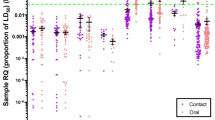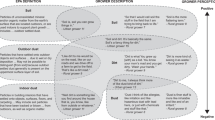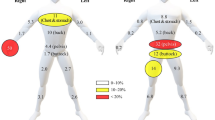Abstract
The US EPA Worker Protection Standard requires pesticide safety training for farmworkers. Combined with re-entry intervals, these regulations are designed to reduce pesticide exposure. Little research has been conducted on whether additional steps may reduce farmworker exposure and the potential for take-home exposure to their families. We conducted an intervention with 44 strawberry harvesters (15 control and 29 intervention group members) to determine whether education, encouragement of handwashing, and the use of gloves and removable coveralls reduced exposure. Post-intervention, we collected foliage and urine samples, as well as hand rinse, lower-leg skin patch, and clothing patch samples. Post-intervention loading of malathion on hands was lower among workers who wore gloves compared to those who did not (median=8.2 vs. 777.2 μg per pair, respectively (P<0.001)); similarly, median MDA levels in urine were lower among workers who wore gloves (45.3 vs. 131.2 μg/g creatinine, P<0.05). Malathion was detected on clothing (median=0.13 μg/cm2), but not on skin. Workers who ate strawberries had higher malathion dicarboxylic acid levels in urine (median=114.5 vs. 39.4 μg/g creatinine, P<0.01). These findings suggest that wearing gloves reduces pesticide exposure to workers contacting strawberry foliage containing dislodgeable residues. Additionally, wearing gloves and removing work clothes before returning home could reduce transport of pesticides to worker homes. Behavioral interventions are needed to reduce consumption of strawberries in the field.
This is a preview of subscription content, access via your institution
Access options
Subscribe to this journal
Receive 6 print issues and online access
$259.00 per year
only $43.17 per issue
Buy this article
- Purchase on Springer Link
- Instant access to full article PDF
Prices may be subject to local taxes which are calculated during checkout
Similar content being viewed by others
References
Barr D.B., Allen R., Olsson A.O., Bravo R., Caltabiano L.M., and Montesano A., et al. Concentrations of selective metabolites of organophosphorus pesticides in the United States population. Environ Res 2005: 99 (3): 314–326.
Barr D.B., Bravo R., Weerasekera G., Caltabiano L.M., Whitehead Jr R.D., and Olsson A.O., et al. Concentrations of dialkyl phosphate metabolites of organophosphorus pesticides in the US population. Environ Health Perspect 2004: 112 (2): 186–200.
Boeniger M.F., and Lushniak B.D. Exposure and absorption of hazardous materials through the skin. Int J Occup Environ Health 2000: 6 (2): 148–150.
Bradman M.A., Harnly M.E., Draper W., Seidel S., Teran S., and Wakeham D., et al. Pesticide exposures to children from California's Central Valley: results of a pilot study. J Expo Anal Environ Epidemiol 1997: 7 (2): 217–234.
Bravo R., Caltabiano L.M., Weerasekera G., Whitehead R.D., Fernandez C., and Needham L.L., et al. Measurement of dialkyl phosphate metabolites of organophosphorus pesticides in human urine using lyophilization with gas chromatography-tandem mass spectrometry and isotope dilution quantification. J Expo Anal Environ Epidemiol 2004: 14 (3): 249–259.
Brouwer D.H., Kroese R., and van Hemmen J.J. Transfer of contaminants from surface to hands: experimental assessment of linearity of the exposure process, adherence to the skin, and area exposed during fixed pressure and repeated contact with surfaces contaminated with a powder. Appl Occup Environ Hyg 1999: 14: 231–239.
CDC. Second National Report on Human Exposure to Environmental Chemicals. NCEH Pub. No. 02-0716. Centers for Disease Control and Prevention, National Center Environmental Health, Atlanta, GA, 2003.
Coronado G.D., Vigoren E.M., Thompson B., Griffith W.C., and Faustman E.M. Organophosphate pesticide exposure and work in pome fruit: evidence for the take-home pesticide pathway. Environ Health Perspect 2006: 114 (7): 999–1006.
Csiszar E., Borsa J., Racz I., and Obendorf S.K. Reduction in human exposure to pesticide using traditional work clothing fabrics with chemical finishing: carboxymethylation and starch. Arch Environ Contam Toxicol 1998: 35 (1): 129–134.
Curl C.L., Fenske R.A., Kissel J.C., Shirai J.H., Moate T.F., Griffith W., and Coronado G., et al. Evaluation of take-home organophosphorus pesticide exposure among agricultural workers and their children. Environ Health Perspect 2002: 110 (12): A787–A792.
Curwin B.D., Hein M.J., Sanderson W.T., Nishioka M., and Buhler W. Acephate exposure and decontamination on tobacco harvesters’ hands. J Expo Anal Environ Epidemiol 2003: 13 (3): 203–210.
DPR. Pesticide Use Report, Annual 2003, Indexed by Chemical and by Commodity. Department of Pesticide Regulation, California Environmental Protection Agency, Sacramento, CA, 2003.
Fenske R.A. Comparative assessment of protective clothing performance by measurement of dermal exposure during pesticide applications. Appl Ind Hyg 1988: 3 (7): 207–213.
Fenske R.A., and Lu C. Determination of handwash removal efficiency: incomplete removal of the pesticide chlorpyrifos from skin by standard handwash techniques. Am Ind Hyg Assoc 1994: 55 (5): 425–432.
Gomes J., Lloyd O.L., and Revitt D.M. The influence of personal protection, environmental hygiene and exposure to pesticides on the health of immigrant farm workers in a desert country. Int Arch Occup Environ Health 1999: 72 (1): 40–45.
Hernandez B., Spencer J., Schneider F., Welsh A., and Fredrickson S. A Survey of Dislodge Residues on Crop Foliage at Field Reentry, HS-1728. Cal/EPA, Department of Pesticide Regulation, Worker Health & Safety Branch, Sacramento, CA, 1997 Available: http://www.cdpr.ca.gov/docs/whs/pdf/hs1728.pdf (Accessed September 8, 2006).
Hernandez B., Spencer J., Schneider F., Welsh A., and Fredrickson S. A Summary of Dislodgeable Foliar Pesticide Residues at Expiration of the Restricted Entry Interval, 1997–2001, HS-1784. Cal/EPA, Department of Pesticide Regulation, Worker Health & Safety Branch, Sacramento, CA, 2002 Available: http://www.cdpr.ca.gov/docs/whs/pdf/hs1784.pdf (Accessed September 8, 2006).
Hornung R.W., and Reed L.D. Estimation of average concentration in the presence of nondetectable values. Appl Occup Env Hyg 1990: 5 (1): 46–51.
Israel B.A., Parker E.A., Rowe Z., Salvatore A., Minkler M., and López J., et al. Community-based participatory research: lessons learned from the Centers for Children's Environmental Health and Disease Prevention Research. Environ Health Perspect 2005: 113: 1463–1471.
Keifer M.C. Effectiveness of interventions in reducing pesticide overexposure and poisonings. Am J Prev Med 2000: 18 (4 Suppl): 80–89.
Kissel J., and Fenske R. Improved estimation of dermal pesticide dose to agricultural workers upon reentry. Appl Occup Environ Hyg 2000: 15 (3): 284–290.
Korpalski S., Bruce E., Holden L., and Klonne D. Dislodgeable foliar residues are lognormally distributed for agricultural re-entry studies. J Expo Anal Environ Epidemiol 2005: 15 (2): 160–163.
Krieger R.I., and Dinoff T.M. Malathion deposition, metabolite clearance, and cholinesterase status of date dusters and harvesters in California. Arch Environ Contam Toxicol 2000: 38 (4): 546–553.
Lander F., and Hinke K. Indoor application of anti-cholinesterase agents and the influence of personal protection on uptake. Arch Environ Contam Toxicol 1992: 22 (2): 163–166.
Lauwerys R.R., and Hoet P. Industrial Chemical Exposure: Guidelines for Biological Monitoring. Lewis Publishers, Boca Raton, FL, 1993.
Lu C., Bravo R., Caltabiano L.M., Irish R.M., Weerasekera G., and Barr D.B. The presence of dialkylphosphates in fresh fruit juices: implication for organophosphorus pesticide exposure and risk assessments. J Toxicol Environ Health 2005: 68 (3): 209–227.
Lu C., Fenske R.A., Simcox N., and Kalman D. Pesticide exposure of children in an agricultural community: evidence of household proximity to farmland and take home exposure pathways. Environ Res 2000: 84 (3): 290–302.
Marquart H., Brouwer D.H., and van Hemmen J.J. Removing pesticides from the hands with a simple washing procedure using soap and water. J Occup Environ Med 2002: 44 (11): 1075–1082.
McCurdy S.A., Hansen M.E., Weisskopf C.P., Lopez R.L., Schneider F., and Spencer J., et al. Assessment of azinphosmethyl exposure in California peach harvest workers. Arch Environ Health 1994: 49 (4): 289–296.
Nigg H.N., Stamper J.H., and Queen R.M. Dicofol exposure to Florida citrus applicators: effects of protective clothing. Arch Environ Contam Toxicol 1986: 15 (1): 121–134.
Obendorf S.K., Kasunick R.S., Ravichandran V., Borsa J., and Coffman C.W. Starch as a renewable finish to improve the pesticide-protective properties of conventional workclothes. Arch Environ Contam Toxicol 1991: 21 (1): 10–16.
Olsson A.O., Baker S.E., Nguyen J.V., Romanoff L.C., Udunka S.O., and Walker R.D., et al. A liquid chromatography—tandem mass spectrometry multiresidue method for quantification of specific metabolites of organophosphorus pesticides, synthetic pyrethroids, selected herbicides, and deet in human urine. Anal Chem 2004: 76 (9): 2453–2461.
Putnam A.R., Willis M.D., Binning L.K., and Boldt P.F. Exposure of pesticide applicators to nitrofen: influence of formulation, handling systems, and protective garments. J Agric Food Chem 1983: 31 (3): 645–650.
Racz I., Borsa J., and Obendorf S.K. Carboxymethylated cotton fabric for pesticide-protective work clothing. Text Res J 1998: 68 (N1): 69–74.
Saleh M.A., Kamel A., el-Demerdash A., and Jones J. Penetration of household insecticides through different types of textile fabrics. Chemosphere 1998: 36 (7): 1543–1552.
Spencer J.R., Sanborn J.R., Hernandez B.Z., Krieger R.I., Margetich S.S., and Schneider F.A. Long vs. short monitoring intervals for peach harvesters exposed to foliar azinphosmethyl residues. Toxicol Lett 1995: 78: 17–24.
US Census Bureau. Poverty Thresholds 2003, Current Population Survey. US Census Bureau, Washington, DC, 2003 Available: http://www.census.gov/hhes/www/poverty/threshld/thresh03.html (Accessed July 23, 2007).
US EPA. Pesticide Worker Protection Standard Training, 40CFR. Vol. Part 170.130 US Environmental Protection Agency, Washington, DC, 1992.
US EPA. Agricultural Transfer Coefficients, Policy number 003.1 US Environmental Protection Agency, Science Advisory Council for Exposure, Washington, DC, 2000.
US EPA. The Worker Protection Standard for Agricultural Pesticides How To Comply Manual. EPA 735-B-05-002. US Environmental Protection Agency, Washington, DC, 2005 Available: http://www.epa.gov/agriculture/htc.html (Accessed August 4, 2006).
USDA. The US Strawberry Industry 1970–2006. 95003. US Department of Agriculture, Economic Research Service (ERS), Washington, DC, 2006 Available at: http://usda.mannlib.cornell.edu/MannUsda/viewDocumentInfo.do?documentID=1381 (Accessed January 10, 2008).
Westgard J.O. Westgard QC: Tools, Technology, and Training for Healthcare Laboratories. Westgard QC, Inc., Madison, WI, 2003 Available: http://www.westgard.com/ (Accessed January 10, 2003).
Zhang X. Human Pesticide Exposure Analysis: Urine Biomarkers of Organophosphorus Insecticides, Malathion, 2,4-D, and Triclopyr [PhD Thesis]. University of California, Riverside, CA, 2005.
Acknowledgements
This research was funded by NIEHS CBPR Grant RO1ES11352. Additional support was provided by US EPA Grant RD 83171001 and NIEHS Grant PO1 ES009605. Analysis for hand rinse, clothing patch, and DFR samples was supported by NIOSH. Additional support for environmental sample collection analysis and M Boeniger's time was provided by NIOSH. The contents of this paper are the responsibility of the authors and do not necessarily represent the official views of the funding agencies. The authors declare they have no competing financial interests. We thank the field staff and the farmworkers and farmers who participated in this study for their valuable time and commitment. We also thank Natividad Medical Center for hosting our field office in Salinas, CA. Finally, we thank J Ferber and R Krieger for their technical assistance.
Author information
Authors and Affiliations
Corresponding author
Rights and permissions
About this article
Cite this article
Bradman, A., Salvatore, A., Boeniger, M. et al. Community-based intervention to reduce pesticide exposure to farmworkers and potential take-home exposure to their families. J Expo Sci Environ Epidemiol 19, 79–89 (2009). https://doi.org/10.1038/jes.2008.18
Received:
Accepted:
Published:
Issue Date:
DOI: https://doi.org/10.1038/jes.2008.18
Keywords
This article is cited by
-
Cultural appropriateness in randomized controlled trials (RCTs) aimed at reducing pesticide exposure among farmers and farmworkers: a systematic review
International Archives of Occupational and Environmental Health (2023)
-
The effectiveness of educational interventions aimed at agricultural workers’ knowledge, behaviour, and risk perception for reducing the risk of pesticide exposure: a systematic review and meta-analysis
International Archives of Occupational and Environmental Health (2022)
-
Real-time particle monitoring of pesticide drift from an axial fan airblast orchard sprayer
Journal of Exposure Science & Environmental Epidemiology (2019)
-
Application of improved approach to evaluate a community intervention to reduce exposure of young children living in farmworker households to organophosphate pesticides
Journal of Exposure Science & Environmental Epidemiology (2019)
-
Estimated exposure of hands inside the protective gloves used by non-occupational handlers of agricultural pesticides
Journal of Exposure Science & Environmental Epidemiology (2017)



